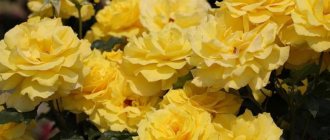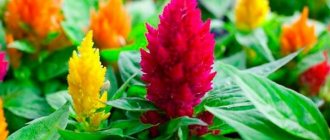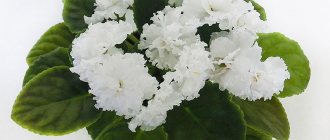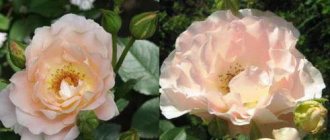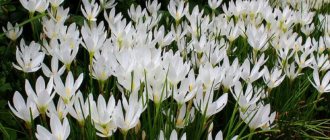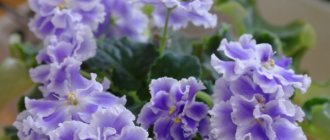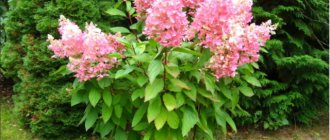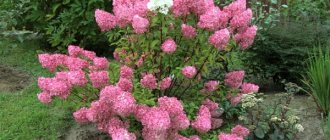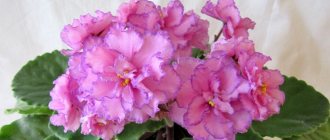Gray fescue (lat. Festuca glauca) is a perennial herbaceous plant of the Poaceae family . The culture is very popular among gardeners and landscape designers, as it is distinguished by its low maintenance, increased resistance to adverse external factors and high decorative value, which remains throughout the season. Gray fescue is a dense spherical bunch consisting of thin elongated leaves of a bluish tint. The plant combines well with other garden crops.
It is found naturally in the Baltic states, Central and Eastern Europe, and Western Ukraine. The plant also grows in the Urals and the Caucasus. Gray fescue is a representative of the numerous fescue genus. The name was given to it by Pliny the Elder, who first described the plant in his famous Natural History.
- Temperature and humidity
- Watering
- Trimming
- Top dressing
- Bloom
- Preparing for winter
Description of the plant
There are several types of fescue, which differ primarily in the color and length of the leaves. The leaves or spikelets are collected in dense bunches ranging from 40 to 120 cm in length and can have a color ranging from purple, like red fescue, to regular green. The roots of all types of fescue are fibrous and usually have a depth of 20-30 cm.
Meadow fescue usually has green leaves and spikelets. The spikelets themselves are not very developed, which reduces the decorative qualities of the plant. The height of the plant is from 60 to 120 cm. But since this type of fescue is used mainly for decorating lawns and open areas, the plant is usually cut. Because of this, its leaves can be up to 20-60 cm high. Meadow fescue is distinguished by soft blades of grass that are pleasant to the feet.
The same simple plant is sheep fescue, which is characterized by shorter grass. This type is also often used to decorate lawns and open areas. Sheep fescue survives drought well, so it can often be found on dry lands or hills.
Gray fescue is the most beautiful species - its leaves have a light bluish color. This plant is most often used for various landscape design figures.
Silver caps of fescue look extraordinary anywhere:
- In the form of borders
- In mixborders
- In vertical clubs
- In the center of horizontal flower beds
For a brighter design, red fescue is used, which has green-pink leaves and red spikelets. The height of this plant is usually 30-40 cm. Photos of fescue perfectly demonstrate how it can create the necessary accents in a flowerbed or mixborder. However, due to its bright color, fescue is used in flower beds and compositions as a single plant.
Varietal types of fescue, such as gray and red, can be found mainly in private areas, parks or other places where the plant is cultivated.
Important! Since fescue is able to inhibit the growth of weeds, it is good to decorate flower bed borders, lawn borders or other places where you need to protect the soil and neighboring plants from green pests.
Types and varieties
The most popular today is gray fescue or Calle . It reaches a height of about half a meter and attracts with its lush bluish foliage with a metallic tint. The flower is paniculate, but inconspicuous.
Filamentous fescue has thin foliage, above which its paniculate flowers rise gently. It goes well with other plants, especially cereals.
Fescue Myra reaches a fairly large height compared to its relatives - its bush can be up to 80 cm. The leaves of this species are thin and tall, which creates a special elegance.
Glacial fescue has a very dense bush, but, unfortunately, it is only suitable for growing in rock gardens.
Fescue or Valis fescue, you need to be careful with this species: although at first it has the cute shape of a small bush, it then begins to multiply uncontrollably, taking over the area around it.
Amethyst fescue bushes look sloppy, but have an interesting shape, which is emphasized by the combination of green and drying foliage. It is also interesting that the color of the leaves of this species changes shade depending on the weather.
Forest fescue forms small bushes, over which panicle flowers flutter easily all summer and autumn.
Sheep fescue is very small, but with its help you can create beautiful thickets from small hummocks.
Paniculata fescue is a charming low, only ten to fifteen centimeters tall including inflorescences, perennial grass. The bright green, graceful, needle-shaped leaves, five to eight centimeters high, are collected in an attractive clump and remain green even in winter. Over time, the hummocks grow and, merging, form beautiful fluffy pillows.
Soil and fertilizing
Although fescue is unpretentious, it does not like acidic soils. In general, the plant gets along well in loose, turfy soils. If the soil is chernozem, rich in humus, then the plant will be fluffy and bright, which is important mainly for species such as red and gray fescue. On dry, poor soils, sheep, meadow or grassy fescue takes root better.
The root system of the plant strengthens, heals the soil and destroys weeds. This is why planting fescue is good for the soil. This plant is an excellent green manure.
The plant is also used to strengthen slopes and prevent landslides. The following fertilizers are used to feed the plants:
- Ashes all season long
- Compost is getting closer to winter
- Mineral fertilizers throughout the season
- Nitrogen fertilizers at the beginning of the season
Botanical description and photo
Glacial fescue Titmouse belongs to the Poaceae family, which has about 300 species . The plant is a lush, dense bush of regular hemispherical shape. It has erect shoots and narrow linear leaves. The height of the plant reaches 40 cm. The shade of the plates is bluish-gray. The leaves of Titmouse fescue are elastic, slightly harsh, which allows the bush to maintain its lush shape throughout the season.
During hot, dry periods, fescue leaves roll into a tube, which reduces evaporation and retains moisture in the tissues.
The variety blooms in June. The duration of this period depends on weather conditions and can be 2-3 weeks. Bare panicle peduncles, up to 4 cm long, confidently rise above the foliage. Initially they have a greenish tint, then they become noticeably lighter and subsequently acquire a brown color. The bottom of the inflorescence is covered with scales and veins. And their upper part is pointed, with long stamens at the end.
The root system of the perennial is quite powerful, going deep up to 1 m . The underground part of fescue is fibrous. Most of the roots are concentrated in the top layer of soil. In the presence of favorable conditions, Titmouse fescue forms creeping underground shoots, which allows the clump to grow.
The fruits of the plant are grains up to 5 mm long. On the front part they, like all cereals, have a groove, and the back side is convex.
The shelf life of Sinichka fescue seeds is 5 years from the date of their collection.
Watering and temperature
The plant prefers moist soils that are regularly and well irrigated. Therefore, questions about how to water fescue usually do not arise. Thanks to its powerful, fibrous roots, the plant easily survives drought. However, the plant does not like areas with very high humidity.
Moreover, due to its low watering requirements, this plant gets along well with other herbs and flowers, which is important for any flower garden and landscape design compositions.
Advice. Despite the small leaves, the plant really does not like watering in the bright sun at its zenith. Despite the fact that the leaves of the plant are quite thin, they can easily get burned by droplets of water in strong sun.
Ornamental plant species and varieties feel best in the middle zone. But they can also be grown in northern or southern regions. Any type of fescue is frost-resistant, so sudden cold weather will not destroy them. Warmer areas are loved by sheep fescue, which grows wild in both forests and hot steppes.
7sotok.by
The content of the article:
1. Planting and caring for fescue.
- Choosing a landing site.
- Soil requirements.
- Nuances of care.
- Preparing for winter.
2. Reproduction of fescue.
- Reproduction by division.
- Propagation by seeds.
- Propagation by seedlings.
3.Use of fescue in garden design.
4.Types and varieties of fescue.
- Low-growing species.
- Medium-sized species.
- Tall species.
The use of grains in garden design is now very popular. A striking representative of this family is fescue, which is loved by gardeners for its unpretentiousness and high decorative qualities.
This perennial herb is valued for its beautiful spherical bushes with needle-like leaves that have a variety of colors.
The mountainous regions of central Europe and Transcaucasia are considered the birthplace of this culture. Today, fescue has more than 150 different species that grow in meadows and forests in areas with cold, temperate and subtropical climates, as well as in mountainous regions of the tropics.
Most have narrow, needle-like leaves that are folded in half. But there are varieties whose leaf width reaches 1.5 cm. Depending on the variety, the color of the leaves can be green, blue, blue-green or silver-blue.
The size and shape of the bush are also varied. And if some varieties can boast compact sizes of no more than 40 cm in height, others can grow up to one and a half meters. The hummock is usually dense, thick, round, but there are species with a looser shape.
Flowering with spreading panicles - spikes - begins in spring and lasts until mid-autumn.
Some of the varieties have the ability to maintain living foliage all year round.
Planting and Care.
For planting, you can use your own plants, obtained by dividing the mother bush or grown from seedlings.
If you decide to purchase this crop in a store or nursery, choose only trusted sellers. When purchasing, carefully inspect the plant; it should have healthy foliage and be compact in shape. It is better to refuse to purchase seedlings with a tangled root system that has grown through the drainage holes of the container.
Choosing a landing site:
Fescue is unpretentious and can adapt to any, even very modest conditions. But its beauty is fully revealed if you fulfill the basic requirements for its location, namely:
· bright lighting;
· dry area.
This culture loves open, sunny areas. Lack of light can affect the color of the leaves. To grow a beautiful bush, choose the warmest, or even better, hot and dry place in the garden. A plant planted in partial shade loses all its decorative effect. In addition, the blue and silver shades of some greens only appear when exposed to sunlight.
For planting, choose a dry, sunny place oriented to the south. Heat and high temperatures do not cause any harm to this crop. Therefore, this grass is successfully used to decorate the southern slopes of rockeries and alpine hills.
Soil requirements:
This plant is undemanding to soil. The only condition is good drainage and the complete absence of stagnant water. It is best if the soil has a light, loose, crumbly texture.
In addition, these cereals do not like soil rich in nutrients. They grow very poorly in soil saturated with humus. Experienced gardeners know that the densest, lush bushes form on the dry, rocky soil of rockeries and rock gardens.
Nuances of care:
Fescue is very easy to care for: by adhering to basic requirements, you can easily get beautiful, thick, healthy plants.
Highly drought-resistant, this cereal requires virtually no watering even in the hottest summer months. Water sparingly only when necessary. Otherwise, the roots may rot and die from excess moisture.
Fertilizing is carried out only in the most extreme cases, when the soil is extremely depleted and this affects the growth and development of the cereal.
In fact, care consists of the following simple procedures:
— spring cleaning of dry leaves;
— removal of faded panicles;
- rejuvenation every 2 - 3 years.
You can remove dry leaves with your hands, or you can comb the mound with a thick rake.
Preparing for winter:
First of all, even at the time of purchasing this crop, try to choose those varieties and species that have already acclimatized to the conditions of your area. The fact is that varieties differ significantly in winter hardiness. Therefore, give preference to plants from local nurseries and gardens.
Grains grown in your climate will not be afraid of low winter temperatures. If, however, some leaves do freeze out, then in the spring they need to be removed, and the hummock will again be overgrown with fresh green foliage.
If the winters in your region are harsh and have little snow, then you can play it safe and cover the fescue with straw, spruce branches, peat or fallen leaves.
Returning to the question of fescue rejuvenation, I would like to note that young bushes are more frost-resistant than old ones. This is explained by the fact that old hummocks gradually die off, weaken and lose their protective properties.
Reproduction.
Reproduction by division:
Reproduction by division is the simplest and most commonly used method. The cereal is usually divided during spring or autumn transplantation. In addition, after about 2 years, the middle of the hummock begins to dry out and die. Therefore, to maintain a beautiful appearance, fescue needs to be rejuvenated by division.
Spring division is carried out before flowering begins. The mother bush is carefully dug up and carefully divided with a knife into parts with several shoots. The resulting cuttings can be immediately planted in open ground.
There is another method of propagation by division, which allows you to obtain already rooted, strong young plants in early spring. To do this, at the end of autumn, an adult healthy bush is carefully dug up and planted in a container in which it is stored until spring at a temperature of about 5 degrees Celsius. The storage room should be dry and sufficiently light. At the end of February - beginning of March, the bush is divided and planted in separate containers. After the threat of frost has passed, young plants are transplanted into the ground.
Propagation by seeds:
Seeds for propagation are bought in a store or collected independently from a flowering adult bush. To obtain seeds, the largest inflorescences, the spikelets, are left to ripen. After flowering ends, they are carefully collected, dried and the seeds are removed.
Soak the seeds you collected yourself in warm boiled water for 3 to 4 hours. After this, disinfect them in a rich pink solution of potassium permanganate. Do not overdo it; too strong a solution may burn the seeds. Treatment with manganese allows not only to destroy pathogens of various diseases, but also gives the seeds a starting supply of manganese. After about 15 minutes, remove the seeds from the solution and rinse well under running water.
You can additionally treat the seeds with growth stimulants.
Seeds purchased in a store have usually already undergone the necessary processing.
Sowing in open ground is done in the spring, after the ground has warmed up sufficiently and the threat of frost has passed, or in late autumn before the onset of cold weather.
Planting holes are made at a distance of 10 - 15 cm from each other. The depth of the hole should not exceed 5 cm. It is best to sow in nests, placing 4 - 7 seeds in each hole at once. Several young plants growing from one hole quickly form a lush tussock.
The seeds are sprinkled with a thin layer of sand on top and watered. After a couple of weeks, the first shoots appear.
In addition, this cereal reproduces very well by self-sowing.
Propagation by seedlings:
In order to obtain strong young plants ready for planting in the ground already in May, fescue is propagated by seedlings. In March, the cereal is sown in small containers with light, loose soil. Seeds are sown directly on the surface of the soil, without deepening. The seeds are also not sprinkled on top. When watered using a sprayer, seeds with sharp tips will themselves go into the soil to the required depth. The top of the container is covered with film or glass, thus creating a greenhouse effect. Place the container with seeds in a warm place with good lighting.
After two to three weeks, when friendly shoots appear, the container is moved to a cooler place. To prevent the seedlings from stretching out, you need to provide them with sufficient lighting.
Water the seedlings very carefully, as excess moisture can cause root rot.
When the seedlings have at least a pair of leaves and their height is at least 3 cm, they are planted in separate containers. You can plant one or 2-3 plants at once in one pot.
Use in garden design.
Fescue is a versatile plant that is suitable for decorating almost any corner of the garden. Most often, this cereal is used as a background or addition to other crops. It looks very impressive against the background of large stones and gravel chips.
Large varieties look great as a frame for paths, flower beds with herbaceous perennials, and bushes. For rock gardens and rockeries, blue fescue and Gouter fescue are widely used. It is also difficult to imagine a steppe flowerbed without gray fescue.
In a flower garden, this cereal is combined with crops that match it not only visually, but also have similar requirements for lighting and soil. Thus, in compositions built on poor, dry soils, together with fescue, you can plant blue carnation, meadowsweet yarrow, and common chinstrap. When planted in humus-rich soil, magnificent geranium, oak sage, and tall varieties of bluebells will become good neighbors.
Types and Varieties.
No more than 20 species of this crop are actively used for garden design.
Depending on their size, decorative types are conventionally divided into:
· short (their height does not exceed 30 cm);
· medium-sized (height from 30 to 60 cm);
· tall (over 60 cm in height).
Low growing species:
Glacial fescue.
It is one of the smallest species. The height of its flowering stems does not exceed 30 cm, and the hummock of leaves itself is even lower. Its homeland is the Pyrenees, where this species grows near the border of glaciers in dense hemispherical hummocks. The flat, narrow leaves are blue or dark blue in color. In winters with little snow it may freeze, but in the spring it quickly grows new foliage..
Paniculata fescue.
The thin, bright green foliage of this species forms such a dense turf that it seems that it is artificial or made of some amazing fur. It grows very quickly, covering the soil with a thick dense carpet, reaching a height of 10 cm. Small, tall panicles are much higher than the main hummock, which at a distance creates the effect of a slight haze over the lush greenery. Requires direct sunlight, although it can grow in light shade. One of the best plants for rockeries.
Filamentous fescue.
It has a rather loose bush structure due to very thin, sharp, long leaves, some of which practically lie on the ground. The foliage is rich green in color and very pleasant to the touch. Due to its decorative qualities, this grass is considered one of the most beautiful plants for rock gardens. Its aerial growth looks especially advantageous in combination with classic dense cereals.
Sheep fescue.
The very tough, thin, brush-like foliage allows this species to withstand even frequent trimming and trampling. The flowerbed of the bush is small, dense, in the shape of a hemisphere. The inflorescences are drooping panicles with light green spikelets. Varieties may differ in leaf color and height.
Medium-sized species:
Gray fescue.
It is a favorite among grasses used in garden design. It has exceptional decorative qualities: it forms a symmetrical hummock and has a very beautiful metallic texture. Silver-blue foliage is evenly distributed throughout the dense, dense semicircular tussock. Grayish-green airy panicles create the effect of a shining halo around the hummock. The intensity of the blue tint depends on the variety and weather conditions.
There are many varieties with different foliage colors: gray, green and blue. The metallic texture of the foliage appears in a steel, silver, platinum or gold tint.
Amethyst fescue.
This species is one of the largest among blue fescue. Forms a symmetrical bush with hard leaves, reaching 50 cm in height and up to 1 m in width. The color of the leaves depends on the composition of the soil and can vary from blue to silver-gray. Tall flower stalks are decorated with purple-light green spikelets.
Mayery fescue.
Graceful arches of hard, glossy leaves give the flowerbed the shape of a sphere. The gray-green foliage is collected in an airy, symmetrical tussock. The inflorescences are large and spreading, but the panicles seem lacy and airy.
Siberian fescue.
Used to create multi-level compositions. Large, graceful leaves, reaching 40 cm in length and 8 cm in width, form a dense, rounded turf of light green color. Light tall panicles repeat the shape of the tussock, forming a second translucent level of the flower garden.
Tall species:
Tall fescue.
The main difference of this species is a powerful, loose and somewhat chaotic hummock. Narrow flat leaves under gusts of wind randomly spread across the ground and create the appearance of a wild, slightly neglected area. Bush up to 1 m tall. Rigid straight peduncles end in wide, spreading golden panicles.
Giant fescue.
The dense growth of this powerful wild species grows up to 1.5 m. A compact tussock is formed from narrow, beautifully curved leaves. Panicles - spikelets, swaying from the slightest breath of wind, create a light golden cloud over the flowerbed.
Mountain fescue (Forest).
Wide, flat linear leaves of this species form a plant up to 1 m tall. Flexible foliage that curls at the ends gives the bush a curly appearance. This plant has a rich color and large panicles - ears.
Planting and growing
Fescue is propagated in a variety of ways:
- Dividing the bush
- Seedlings
- Seeds
Fescue seeds germinate easily and quickly and immediately begin to actively grow. Shoots appear already 4-6 days after sowing. The sprouts rise and develop quite rapidly, within 1-2 weeks after emergence they turn into full-fledged seedlings, ready for open ground. Planting seedlings or adult bushes in the ground can be done from the beginning of April. It is better to cover young seedlings with some kind of material.
It is also possible to sow seeds directly into open ground. To prevent the shoots from dying, it is better to sow in late April - early May.
Important! Sowing seeds in open ground is usually used when decorating lawns, lawns and fields. Single seedlings are usually used for use in landscape design.
Advice. Since plant seedlings appear very quickly and their development is fleeting, growing this plant from seeds can be interesting for children. The child will be able to observe how a whole bush and a small seed develop. In this case, he will not have time to get tired of this plant.
Possible difficulties
Even a novice gardener can cope with growing perennials.
However, in some cases, ignoring the rules of care can lead to problems. The most common of them :
- Sharp wilting of bushes . This occurs when there is prolonged stagnation of moisture in the soil, which causes rotting of the root system. It will not be possible to save such a plant.
- Slow development of bushes . The problem occurs when planting in heavy soil and over-fertilizing. In this case, it is necessary to replant and adjust the care.
Note ! After planting, birds can peck seeds from the soil, so it is recommended to cover the area with agrofibre.
Diseases and pests
The fescue plant is resistant to various diseases and pests. Ticks, aphids and other insects rarely pay attention to it. For this reason, fescue will be useful in compositions, as its presence will inhibit the migration of insects from plant to plant.
Among the diseases, fescue can be affected by fungus or mold if the plant lives in very moist, slightly swampy soil. To get rid of the disease, you just need to trim off the affected foliage.
Simple and unpretentious fescue lives 10-15 years. During this period, she will decorate the garden and also make the living of her plant neighbors more comfortable.
Growing conditions for gray fescue
The location for planting fescue must be sunny. Shading by buildings or tall plants is undesirable - this significantly reduces the decorative effect of the plant.
Regular soil will do. The main thing is that it is well drained, loose and breathable; it is quite possible that it is rocky and gravelly.
Watering is required only in hot weather or a long absence of rain. If the plants are well mulched with gravel or wood chips, watering can be kept to a minimum.
Photo of fescue
Application in landscape design
Its main purpose is as a ground cover plant. This crop is the most common in the gardens of our climate zone. The grass is used as a background plant, filling all the gaps, in ridges, flower beds, mixborders, borders. Only blue fescue is used in carpet flower beds. They are planted in entire tracts near dwarf and medium-sized shrubs. You can find plants planted in baskets and containers, near flowering summer plants. Plays an important role in the design of rock gardens. Being a background or an addition to the main elements of the composition, gray fescue helps the ensemble achieve a complete and holistic image.
The plant is universal. It goes well with almost all flowers and shrubs, and looks beautiful against the backdrop of garden furniture, decorative items, gravel, and boulders. If hewn logs are used instead of benches, then planting grass around will create a natural and natural look. The same effect will be produced by culture on the shore of a natural or artificial reservoir. The slight swaying of the grass from the slightest breath of wind brings a calming aura and a romantic mood. The modest charm of fescue, combined with its expressive needle-like leaves, completes the look of any garden plot.
The New Wave landscape style, which uses a combination of different types of cereals, assigns fescue the role of not only a background, but also a basis in compositions. The color, texture and movement of the plant allows you to give the garden absolute naturalness, without traces of human intervention. The changing color of the bush throughout the year allows you to combine plants around it that bloom in different periods. In this case, the composition will transform on its own, without requiring the gardener’s attention. In winter, the plant is visible from under the snow and attracts many birds, which fill the garden with their singing.
At first, fescue is planted on side auxiliary beds due to its slow growth. When the plant fully assumes the role of a decorative element of the garden, it is moved to an area that can be viewed from different points. There the fescue will be able to fulfill its main purpose - to create a magically beautiful landscape. Grasses provide a canvas on which a skilled designer will create vibrant colors by planting flowering shrubs, evergreens and colorful flowers nearby.
Reproduction methods
Fescue can be propagated by seed or by dividing the bush.
If you do not trim the inflorescences, the plants will reproduce by self-sowing. Therefore, if there are empty spaces in the lawn, you can postpone mowing it until next year and wait until all the empty areas are completely overgrown with grass.
The division of the bush is carried out in this way:
- Using a garden shovel, you need to dig up bushes that are too lush and overgrown and divide them into several parts.
- Make shallow holes in the ground and plant parts of the divided bush in them. The dried core of the bush will need to be thrown away.
- Gently water the young plants using a garden watering can.
Rules for preparing for winter
Preparations for winter require varieties with low frost resistance that grow in regions with harsh winters. Such plants are covered with dry leaves, straw or special protective material. However, you cannot be too zealous with the shelter, since during the thaw period the fescue may dry out.
Before the onset of frost, the lawn is cut, but not too short (to about 5 cm in height). If you leave tall grass unmowed, then with the onset of frost it will wither and interfere with the growth of new shoots in the spring.
Distribution of red fescue in nature
The fescue plant is found in almost all undisturbed fields and meadows. The grass easily tolerates moisture and germinates on all types of soil. This wide distribution is explained by its high wear resistance, since even in the most mineral-poor soils the culture germinates, showing its endurance and durability.
Red fescue (Festuca rubra rubra)
The impact of temperatures and their sudden changes also do little to scare fescue, since the grass is very frost-resistant, is not afraid of arid climates, and tolerates long-term shading. This is why sesame is rightfully considered one of the best grasses for the lawn.
Use in landscape design
Red fescue is a lawn grass that is suitable for landscaping any type of soil. It easily takes root in open ground, in containers and flowerpots. The plant can be used to create perennial compositions with trees, flowers and shrubs. However, most often it is used for uniform sowing and design of lawns. They turn out to be bright and stable, and within a few years they are completely filled with ornamental fescue grass.
Fescue is suitable for landscaping areas of soil that are not planned to be used in the next few years. The plant grows and acquires a decorative appearance only the next year after sowing.
Red fescue is a spectacular type of lawn grass for home and garden, parks and recreation areas, and landscape compositions. Its main advantages are its affordable price, ease of cultivation, and the ability to combine with other herbs. With minimal care, the lawn grows bright, uniform and neat.
Rules and features of transplantation
Due to its unpretentiousness and endurance, the culture tolerates transplants well . However, they can only be carried out in cloudy weather, in the morning or evening.
Every 3-4 years, fescue should be rejuvenated by dividing and planting old bushes in new places. Otherwise, the grass will begin to dry out and turn yellow.
The transplantation process is carried out in early spring or autumn . For dividing bushes, it is allowed to use only plants older than 2-3 years.
How to properly care for a plant in the garden
Gray fescue has many advantages: not only is it completely undemanding to soil, it tolerates both high and low temperatures, it almost does not need watering and fertilizing, and maintaining the decorative appearance of the bush is not particularly difficult.
Watering
Excess moisture is something that should absolutely not be allowed when caring for fescue. The roots begin to suffer: they rot and die, as a result of which the entire plant dies.
You should water the bushes very moderately, only if necessary: it is better to have little water than too much.
Fertilizer rules
Fescue is completely undemanding when it comes to soil: it likes loamy, rocky, and sandy soils.
Only in cases of extreme nutritional need, when the plant grows and develops worse, is it permissible to additionally fertilize the soil in which it grows.
Fertilizers are applied organic or mineral; the dosage specified in the instructions cannot be exceeded. Excess nutrients can have a detrimental effect on ornamental perennials.
Trimming
When spring comes, the cereal must be rid of deteriorated leaves and dead fragments, which will improve the appearance of the ornamental plant. This can be done either manually or with the help of a rake, which, due to the rigidity of the leaves, will not damage the aesthetic component of the fescue. After the bush fades, you need to cut off the flower stalks to preserve the appearance. If you need to collect seeds, you should leave the largest flower stalks until they are fully ripe.
Gray fescue is a real decoration of any garden, which is quite easy to grow even for a beginner. The plant is hardy: it withstands high temperatures with dignity, while being frost-resistant. Minimal growing conditions and care are required. The disadvantage is the impossibility of planting fescue in shaded areas, and it does not tolerate dampness. If the plantings are large, caring for them can be quite labor-intensive, due to the need to periodically divide and rejuvenate the clumps.
